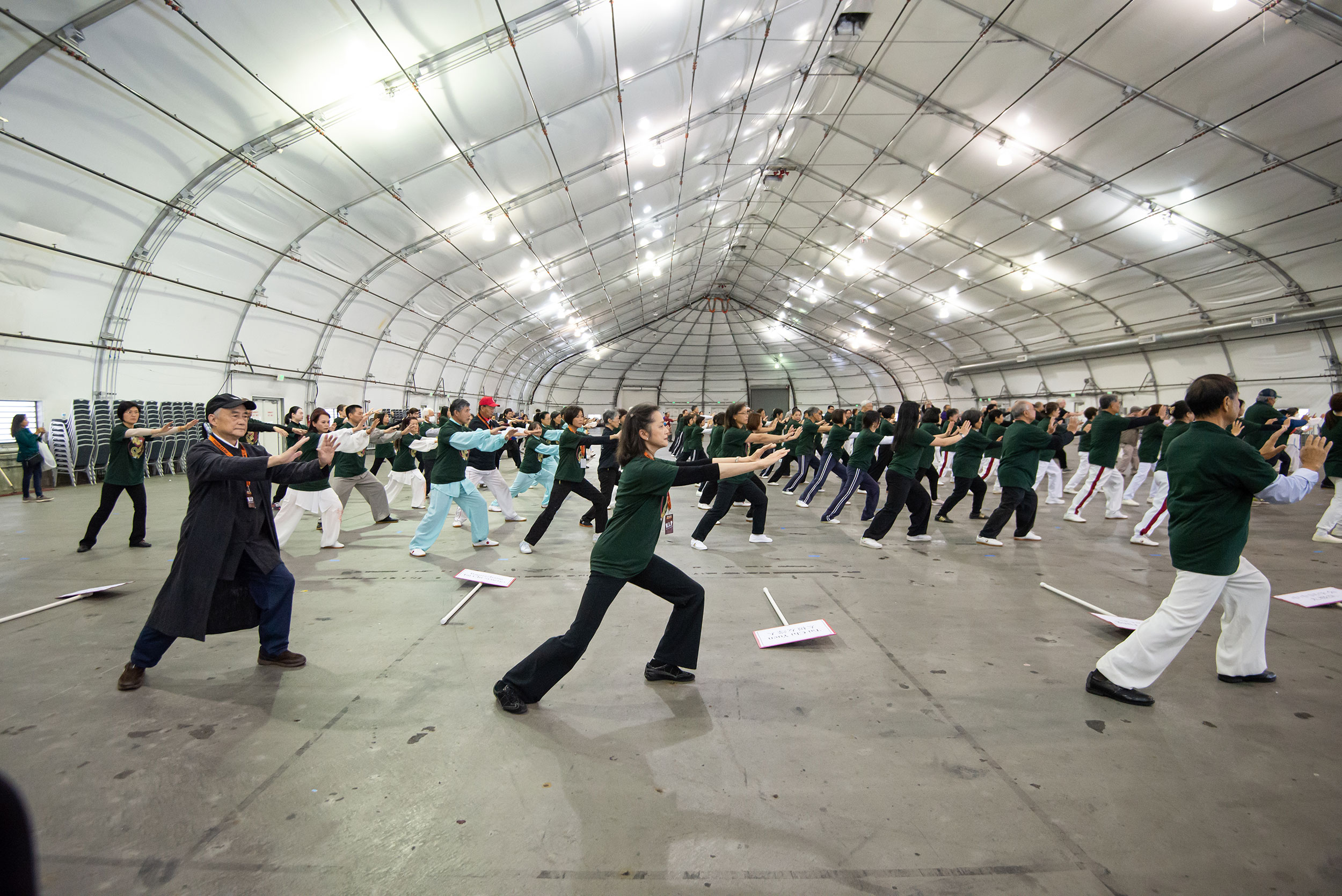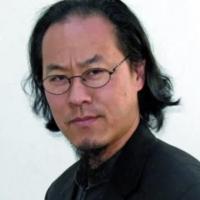On Saturday, April 27th, 2024, we celebrate World Tai Chi & Qigong Day. What began on as a promotional Tai Chi club gathering has blossomed into global event, observed on the last Saturday of April every year. It all started back in 1998 when World Tai Chi & Qigong Day founders Bill and Angela Wong Douglas organized a 200-person mass tai chi exhibition on the lawn of the Nelson Atkins Museum of Art in Kansas City, Mo. The grandeur of the recital was picked up by CNN, and that exposure led to the establishment of World Tai Chi & Qigong Day the following year. In the spirit of the event, mass tai chi and qigong recitals, teach-ins, and exhibitions are held for free and open to the public, all around the planet. It has been a wonderful way to educate the public about tai chi and share this precious legacy.
At the heart of World Tai Chi & Qigong Day is the mass tai chi recital. A mass tai chi recital is when a large group of people get together to practice the same form in a synchronized fashion. While there isn’t a hard definition of how many people must participate to constitute a mass gathering, a mass gathering is colloquially defined as a planned event for a specific location, period of time and purpose for a large group. In the legal definition, the gathering must be large enough to impact the community to require extra multi-agency response (additional law enforcement and medical support), so it is often regarded as well over a thousand participants. Most tai chi mass recitals fall way short of level of magnitude, although some recitals in China number in the tens of thousands (which will be discussed later in this article). Most are far more modest. Here in North America, a few hundred participants warrant classification as a mass tai chi recital. Although as the notion spreads, attendance has grown, slow and steady, like tai chi progression can be.
Unfortunately, there was a hiccup. Mass gatherings were discouraged during the pandemic. This interrupted the constant growth World Tai Chi & Qigong Day had been experiencing since 1999. It also prompted the rise of Mass Gathering Medicine, a new niche field that was a positive byproduct of the pandemic. Beginning with potential of communicable diseases in crowds, Mass Gathering Medicine has expanded to include emergency medicine. It has become a focus of the Department of Global Alert and Response of the World Health Organization.
To our way of thinking, mass tai chi recitals are a special form of mass gathering medicine. But again, in all fairness, tai chi recitals fall way short of these definitions of ‘mass gatherings,’ unless in China. If we were to be pedantic, tai chi recitals are more of large group than a mass one.
China’s Mass Tai Chi Recitals
China is the cradle of tai chi and with a population over 1.4 billion, it stands to reason that the largest tai chi recitals have been staged there. While I have yet to experience a true Chinese mass tai chi recital, I have been to the First World Traditional Wushu Festival held in Zhengzhou and Dengfeng, on the way to Shaolin Temple. That was filled with mass Shaolin kung fu demonstrations – literally tens of thousands of practitioners demonstrating Shaolin kung fu in tandem. The power of that witnessing that firsthand was overwhelming and remains a personal source of inspiration to this day.
But back to tai chi, one of the first major mass tai chi recitals to make international news was in 2007. In honor of the 10th anniversary of Hong Kong’s Special Administrative region, a recital was held on the site of the former Kai Tak airport that allegedly reached over 20,000 participants.
That was dwarfed in 2009. In honor of the anniversary of the Beijing Olympics, China established National Fitness Day and in celebration, a mass tai chi recital was staged on August 8th at the Olympic stadium in Beijing with 33,996 participants. If that number seems astonishingly exact, it is because it was officially measured and certified by the Guinness Book of World Records as the largest mass tai chi recital at the time.
It was bested on October 18, 2015, when Chen village, the birthplace of Chen Tai Chi, staged the ‘largest martial arts display (multiple venues)’ in the Jiaozuo city, part of the Chenjiagou Scenic Area Administration. This holds the current Guinness World Record at 53,803 participants.
Just prior to the pandemic, Chen village staged another mass tai chi recital as part of the launch of the historic international ‘Belt and Road’ Tai Chi Tour where tai chi grandmasters toured the world to share their treasured art. That mass tai chi recital was estimated at over 10,000 participants. It was a fraction of their world record setting recital, but 10,000 practitioners are still noteworthy.
Being One with the Crowd
My first and only personal experiences with mass tai chi recitals has been an artifact of my work as a tournament promoter. Since its beginnings in 2006, I have served as a promoter for the Tiger Claw Elite Championships in San Jose, California. I help oversee the KungFuMagazine.com portion of that tournament, which was hosted by Kung Fu Tai Chi, the newsstand magazine I published until covid killed it. In 2012, we celebrated the 20th anniversary of Kung Fu Tai Chi, and in honor of that milestone, San Jose officially declared ‘Kung Fu Tai Chi Day.’ We held free demonstrations and workshops, as well as hosted vendor booths and gourmet food trucks, all in Plaza de Cesar Chavez, the central downtown park. We’ve celebrated Kung Fu Tai Chi Day on the second day of our tournament ever since.
Including a group tai chi recital was a natural for Kung Fu Tai Chi Day. We used one of the most popular short forms in the world - Simplified 24 Taiji. We wanted to be as inclusive as possible, so this was the logical choice because it’s easy for anyone to follow it.
Since then, our Sunday Group Tai Chi Recital of Simplified 24 Taiji has become a crowd favorite. We’ve been getting several hundred participants every year. We know because we sell a commemorative T-shirt. There’s something especially unifying when everyone dressed uniformly. We don’t require participants to wear them (I never do because I’m an MC so I must dress more formally to stand out), but those who aren’t wearing the official colors are kindly asked to be in the back so as not to disrupt those glorious photographic moments.
The 24 isn’t part of my practice regimen. I practice Sun style Taiji which is quite different. I’ve never been formerly instructed on the 24. I learned it off video. The first time I learned it, I spent a month reciting it daily. However, over the years, I’ve let it go. Now I just follow along next to someone who knows how it goes. But unless there’s some catastrophe at the tournament, I love to participate.
Why? It’s the qi.
We talk about qi in tai chi a lot, and there is nothing like the sensation of reciting tai chi in a large, synchronized group. You can get a sense of it when practicing synchronized forms with a few classmates. There’s something contagious about the flow of qi when your surrounded by other practitioners reciting the same form. This seems amplified with tai chi for some reason. Perhaps it’s because it has a mellower vibe, one that is more fluently shared. If you glean some qi boost from reciting a form with a couple of fellow classmates, that increases tenfold when there’s a few dozen participants and a hundredfold when there are hundreds.
There’s nothing else like participating in a large group tai chi recital. I fully encourage you to do so if you get the chance. Hopefully, as the pandemic fades into memory, World Tai Chi & Qigong Day will get back on track and provide more opportunities for everyone to participate.
The above is an original article by Gene Ching, Staff Writer for YMAA Publication Center.






